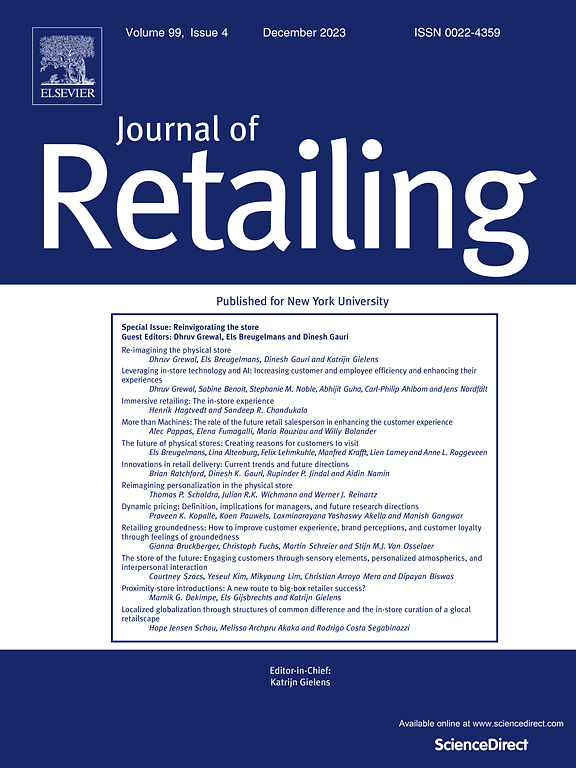Friends or Enemies? The impact of partial competitor referral on consumer purchase
IF 10.2
1区 管理学
Q1 BUSINESS
引用次数: 0
Abstract
Partial competitor referral is a common sales influence tactic used to increase consumers’ likelihood of purchasing a focal product (e.g., a painting or table) by referring consumers to a competitor that offers a non-focal product (e.g., a frame or chairs). This study examines the impact of two types of partial competitor referrals, i.e., recommending a competitor with strategic vs. tactical advantages, and their impact on consumers’ purchase intention. Five studies showed that recommending a competitor with strategic (vs. tactical) advantages on a non-focal product increases consumers’ purchase intention of the focal product. Credibility of the referral signal and trust of the seller (e.g. goodwill, integrity, and competence trust) mediate the effects. Skepticism toward salespeople, the presence of monetary incentives for referrals, and seller-competitor product assortment overlap moderate the effects. Additionally, we found that recommending a competitor with strategic (vs. tactical) advantages on a non-focal product decreases consumers' future purchase intention for the non-focal product. Theoretical contributions and practical implications of our research are discussed.

朋友还是敌人?部分竞争对手推荐对消费者购买的影响
部分竞争对手推荐是一种常见的销售影响策略,通过将消费者推荐给提供非重点产品(如框架或椅子)的竞争对手,来增加消费者购买重点产品(如绘画或桌子)的可能性。本研究考察了两种类型的部分竞争对手推荐的影响,即推荐具有战略优势的竞争对手与战术优势的竞争对手,以及它们对消费者购买意愿的影响。五项研究表明,推荐在非重点产品上具有战略(vs.战术)优势的竞争对手会增加消费者对重点产品的购买意愿。推荐信号的可信度和卖家的信任(如商誉、诚信和能力信任)起到中介作用。对销售人员的怀疑,对推荐的金钱激励的存在,以及卖方-竞争对手的产品分类重叠缓和了这种影响。此外,我们发现,推荐在非焦点产品上具有战略(相对于战术)优势的竞争对手会降低消费者未来对非焦点产品的购买意愿。讨论了本研究的理论贡献和现实意义。
本文章由计算机程序翻译,如有差异,请以英文原文为准。
求助全文
约1分钟内获得全文
求助全文
来源期刊

Journal of Retailing
BUSINESS-
CiteScore
15.90
自引率
6.00%
发文量
54
审稿时长
67 days
期刊介绍:
The focus of The Journal of Retailing is to advance knowledge and its practical application in the field of retailing. This includes various aspects such as retail management, evolution, and current theories. The journal covers both products and services in retail, supply chains and distribution channels that serve retailers, relationships between retailers and supply chain members, and direct marketing as well as emerging electronic markets for households. Articles published in the journal may take an economic or behavioral approach, but all are based on rigorous analysis and a deep understanding of relevant theories and existing literature. Empirical research follows the scientific method, employing modern sampling procedures and statistical analysis.
 求助内容:
求助内容: 应助结果提醒方式:
应助结果提醒方式:


